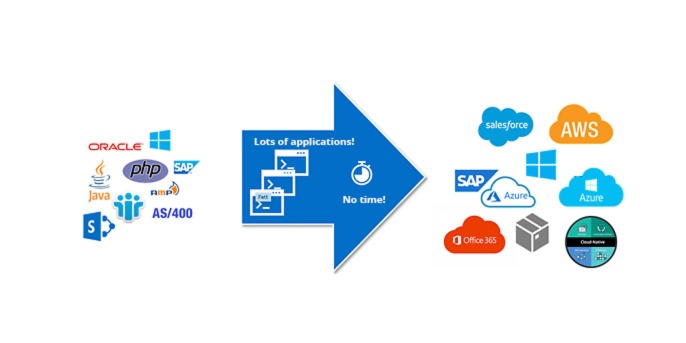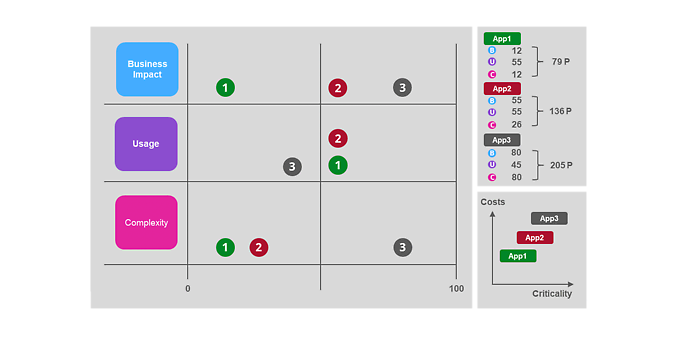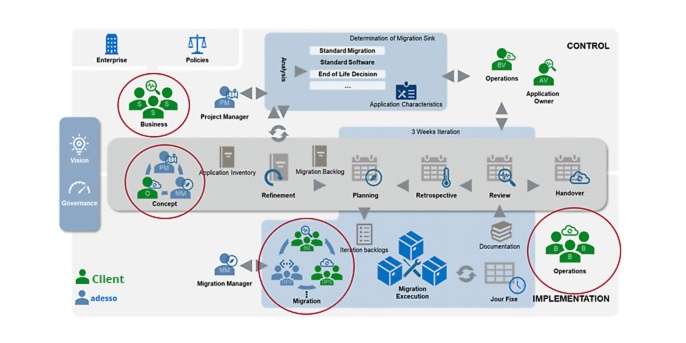4. November 2021 By Marcus Peters and Maximilian Morlock
Cloud migration – Let’s get specific, please!
The cloud has caught on in the minds of decision-makers. There’s no doubt about it. Many companies, however, struggle to develop a true cloud strategy that provides a basis for technological evolution and follows a concrete transformation vision. In addition, it’s often unclear which concrete steps have to be taken to transfer the applications after the decisions to switch to the cloud which cloud provider to use have been made. It’s no wonder that an Internet search for checklists and strategies leads to thousands of results that are unfortunately mostly superficial. How should decision-makers find an effective entry point then?
This blog post aims to fill this gap and present concrete steps on how to proceed.
The challenge
The starting point for making considerations lies at the very beginning: the decision for a single-cloud or multi-cloud environment has been made, and now all the applications need to be moved to the cloud. And since the decision to move to the cloud has often already taken a while, you now want to get started quickly. This puts pressure on the organisational process at an early stage.
If a mixture of platform and best-of-breed approaches is part of the IT strategy as well, the target environment then consists of various hyperscalers and ‘Something-as-a-Service’ systems. This means that many things on one side have to be sorted into many things on the other side.

The typical dilemma of a cloud migration: Many applications from different platforms are to be quickly migrated into the multi-cloud environment.
But that’s not all, because the domestic system landscape in many companies already exists as a mature environment of diverse technologies and systems.
This means that there are already enough ingredients in the mix for a project to become a disaster, as illustrated in the first figure: many different applications and systems have to be transferred very quickly to many different systems in the cloud.
The cloud migration factory solution
In order to be successful with such projects, two decisive factors have to be considered. First of all, a tough decision has to be made for each application as to whether, where and how it should be transferred. Secondly, an agile factory approach is needed for quality-controlled migration to happen in a short period of time, which in practical terms is only limited by the number of people or financial resources you have.
The second factor shows such a procedure’s typical workstations.

Cloud Migration Factory workstations
The importance of the application to the organisation process is assessed at the technical classification workstation. Then, the decision for migration is made and its urgency is determined. Next, the target environment is defined based on professional and technical criteria. Once a decision for the implementation has been reached, the migration is carried out and quality is assured. After a successful transfer, the application is put into operation and is available to users in the cloud after a stabilisation phase (which entails change management and training).
Technical classification and migration concept
As shown above, this approach involves making a decision about functional migration, defining the target environment and setting a priority for each application.
The following points are typical evaluation criteria that are needed to achieve this result:
- The further along its life cycle an application is, the more closely it should be examined as to whether the benefits are worth the expected effort it will take to carry out the migration. The value the application contributes to business operations is an important criterion when performing this examination.
- The determination of complexity serves as an indicator for how much effort it will take to carry out the migration due to technical parameters.
- If the application is based on a standard solution or product, a decision must be made as to whether there is a variant of the cloud on the market that includes a migration path or to which of the selected cloud services the application should be transferred.
- If the application is an in-house development, a decision must be made as to whether a product might be a better fit. Alternatively, it must be decided what the phases for the cloud-native application should look like or whether a simple lift and shift or containers are sufficient.
- In addition, the impact in terms of safety requirements and price elasticity as well as performance elasticity are to be determined: how many people and which roles use the application currently and in future, and what volumes of data will be generated.
In order to meet the time requirements for moving into the cloud quickly, it makes sense to establish a key figure model that can be used to optimise the decision-making process. The procedure allows the different key figures to be compared to aid in the decision-making process. The third figure shows a simple key figure model in which an assessment of effort and criticality can be made using a points system and three categories.

Illustration of a simple key figure model
Starting up the factory
Once the discussed workstations and procedures have been established in a way similar to the approach above, the factory can be booted up and, after the typical settling phase for agile contexts, started up.
For this, having a description of the workstations’ result types that is as accurate as possible helps to ensure the process runs smoothly. A central directory of all the applications considered for analysis, for example, can serve as the input channel for the analysis, and a migration backlog can constitute the list of the analysed and approved applications for migration.
In keeping with the practice of thinking ahead, the aspects of quality assurance and exception handling in the factory are also important to deal with before continuing with regular operation once you’re done.
Depending on the situation, thousands of applications often move from a data centre to the cloud over a period of years. And as time moves on, this factory approach helps to manage people, material and throughput.
This approach can offer additional benefits when implemented in mixed teams should a service provider be brought in for this endeavour. Such cooperation yields valuable results, such as economies of scale and the exchange of expertise. The fourth figure illustrates the fully deployed factory and demonstrates the aforementioned mixed operation.

Overall view of the Cloud Migration Factory with workstations and control according to agile procedure
Having been anchored in elements of agile organisation for controlling the project, the move to the cloud can be carried out successfully.
Conclusion
The phrase ‘divide and conquer’ removes the dread from these complex projects. Using a coordinated process to reach the decision to migrate makes it rather simple to create a comprehensible list of the applications to be migrated. The subsequent steps can then be carried out according to almost purely technical aspects, which in most cases are not incredibly difficult to comprehend. This type of well-structured project can deliver fixed results and thus yield a nice mutual contribution of added value from specialist departments and IT.
Would you like to learn more about exciting topics from the world of adesso? Then check out our latest blog posts.


